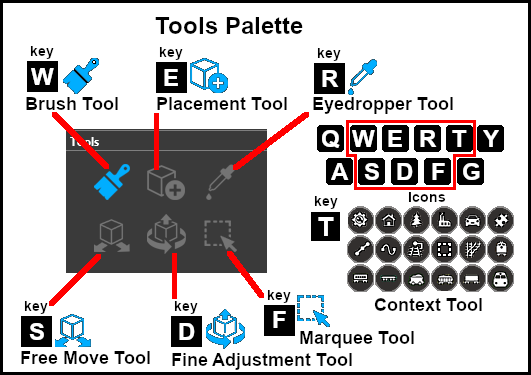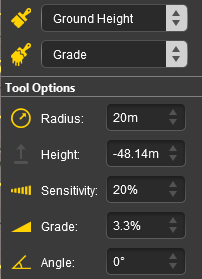How to Use S20 Tools
m (→Ground Height) |
m (→ Ground Height ) |
||
| Line 183: | Line 183: | ||
<tr valign="top"> | <tr valign="top"> | ||
<td>[[image:DotPoint.JPG|link=]]</td> | <td>[[image:DotPoint.JPG|link=]]</td> | ||
| − | <td>The <span style="font-size: 15px; font-weight: 700; color: gold; background-color: black;"> Grade </span> may cause some confusion. It is defined as '''height''' (vertical) over '''distance''' (horizontal) | + | <td>The <span style="font-size: 15px; font-weight: 700; color: gold; background-color: black;"> Grade </span> may cause some confusion. It is defined as '''height''' (vertical) over '''distance''' (horizontal) converted to a percentage figure. So a grade of 100% (the maximum allowed) would mean a slope formed by the height and distance being the same (e.g. a height of 50m rising over a distance of 50m). A vertical slope (a cliff) would have an infinite grade which is currently impossible in Surveyor.</td> |
</tr> | </tr> | ||
<tr valign="top"> | <tr valign="top"> | ||
<td>[[image:DotPoint.JPG|link=]]</td> | <td>[[image:DotPoint.JPG|link=]]</td> | ||
| − | <td>Unlike in '''Surveyor Classic''', there | + | <td>Unlike in '''Surveyor Classic''', there appears to be no upper limit to the brush <span style="font-size: 15px; font-weight: 700; color: gold; background-color: black;"> Radius </span>. Brushes of hundreds of metres (and greater) in size are possible. However, if you are using the brush to set a specific height to an entire baseboard, or to many baseboards, then the '''Marquee Tool''' may be a better choice.</td> |
</tr> | </tr> | ||
</table> | </table> | ||
| Line 193: | Line 193: | ||
</tr> | </tr> | ||
</table> | </table> | ||
| + | |||
| + | ===<span style="color: white; background-color: blue;"> Ground Terrain </span>=== | ||
| + | |||
| + | |||
| + | ===<span style="color: white; background-color: blue;"> Scrapbook Data </span>=== | ||
| + | |||
| + | |||
| + | ===<span style="color: white; background-color: blue;"> Edit Effect Layers... </span>=== | ||
=='''The Placement Tool'''== | =='''The Placement Tool'''== | ||
Revision as of 08:02, 6 January 2023
The information in this Wiki Page applies to Surveyor 2.0 (S20) as found in Trainz Plus.
This document is under development
|
|
|||||||||
The Tools Palette
 |
|
|||||||||||||||
The Brush Tool
The Brush Tool is used for painting the landscape. It can:-
When selected, the Brush Tool will show two drop down menu lists. |
 |
The first drop down menu will set the Brush Target, the type of brush. The Targets are:-
|
 |
Ground Height
When this Target is selected, the second drop down box will display a selection of Ground Height tools. The choices are:-
|
 |
The Ground Height Tool selection will determine which of the standard Brush controls will be available for use in the Tools Options Palette. If this palette is not shown on the screen then refer to the Notes at the top of this document.
Height Up/Height Down  |
Set Height  |
Grade  |
|
||||||||||
| Brush controls that are available for each selected tool are shown with a Gold coloured icon next to their names. | |||||||||||||
|
Ground Terrain
Scrapbook Data
Edit Effect Layers...
The Placement Tool
| Keyboard Shortcut: E |
The Placement Tool is used to add assets to the landscape.
The Eyedropper Tool
| Keyboard Shortcut: R |
The Eyedropper Tool is used to identify objects that are in the landscape. The objects can be textures, effect layers, scenery, rolling stock, track and track equipment, and splines.
The Free Move Tool
| Keyboard Shortcut: S |
The Free Move Tool is used to move objects in the landscape.
The Fine Adjustment Tool
| Keyboard Shortcut: D |
The Fine Adjustment Tool is used to make fine adjustments (XYZ axis, rotation, tilt) to objects in the landscape.
The Marquee Tool
| Keyboard Shortcut: F |
The Marquee Tool is used to select areas of the landscape.
Trainz Wiki
 |
More Tutorials and Guides to Using Trainz |
This page was created by Trainz user pware in January 2023 and was last updated as shown below.
